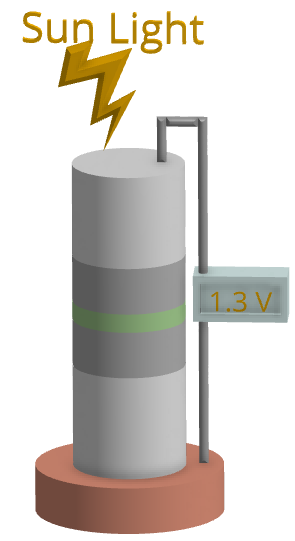Simulación de celdas solares de banda media como herramienta en la enseñanza de la física
Palabras clave:
Solar Cells, Semiconductors, SimulatorResumen
Renewable energy sources are changing the way we live and one of the most promising examples is the use of solar cells to harness energy. With the increasing demand for clean energy, it's crucial to understand the underlying physical concepts behind the operation of solar cells. However, this can be a challenge, even for undergraduate physics students, as the concepts are often linked to nanoscale phenomena that don't have classical analogs. Additionally, the mathematical formalism can be difficult to grasp, as analytic solutions aren't always available. To overcome these obstacles, we propose to utilize modern programming platforms to numerically solve the Schrödinger equation in the context of intermediate band solar cells, a special kind of solar cells. With the code and simulator we provide, students can easily estimate eigenfunctions, eigenenergies, and absorption probabilities without struggling through manual calculations. This approach focuses primarily on how the devices work and helps students see the relationship between structural parameters and light-to-current conversion efficiency in real-life applications. Hence, using numerical tools and simulations to understand semiconductor device physics makes the learning process more accessible and engaging for students. It's a step forward in fostering a deeper appreciation and understanding of renewable energy technology and its impact on our daily lives.
Citas
LD Carr and SB McKagan. Graduate quantum mechanics reform. American Journal of Physics, 77(4):308–319, 2009. URL https://shorturl.at/hlqMZ.
Chandralekha Singh. Student understanding of quantum mechanics. American Journal of Physics, 69(8):885–895, 2001. URL https://shorturl.at/yGRST.
Fernanda Ostermann and Marco Antonio Moreira. Uma revis˜ao bibliogr´afica sobre a área de pesquisa física moderna e contemporânea no ensino m´edio. Investiga¸c˜oes em ensino de ciências, 5(1):23–48, 2016. URL https://shorturl.at/mBJM7.
Hauke C Busch. Using environmental science as a motivational tool to teach physics to non-science majors. The Physics Teacher, 48(9):578–581, 2010. URL https://doi.org/10.1119/1.3517020.
Marta L Dark. A photovoltaics module for incoming science, technology, engineering and mathematics undergraduates. Physics Education, 46(3):303, 2011. URL https://iopscience.iop.org/article/10.1088/0031-9120/46/3/008/pdf.
Mark B Schneider. Quantum mechanics for beginning physics students. The Physics Teacher, 48(7):484–486, 2010. URL https://doi.org/10.1119/1.3488198.
Anibal T Bezerra and Nelson Studart. Lifetime enhancement for multiphoton absorption in intermediate band solar cells. Journal of Physics D: Applied Physics, 50(30):305501, 2017. URL https://iopscience.iop.org/article/10.1088/1361-6463/aa795a/pdf.
Bernard J Feldman. An introduction to solar cells. The Physics Teacher, 48(5):306–308, 2010. URL https://aapt.scitation.org/doi/abs/10.1119/1.3393060?journalCode=pte.
Girolamo Di Francia. Conductors, insulators, and solar cells: A simple introduction. The Physics Teacher, 59(5):363–366, 2021. URL https://doi.org/10.1119/10.0004889.
William Shockley and Hans J Queisser. Detailed balance limit of efficiency of p-n junction solar cells. Journal of applied physics, 32(3):510–519, 1961.
Antonio Luque and Antonio Mart´ı. Increasing the efficiency of ideal solar cells by photon induced transitions at intermediate levels. Physical Review Letters, 78(26):5014, 1997. URL https://journals.aps.org/prl/pdf/10.1103/PhysRevLett.78.5014.
M Yoshida, NJ Ekins-Daukes, DJ Farrell, and CC Phillips. Photon ratchet intermediate band solar cells. Applied Physics Letters, 100(26):263902, 2012. URL https://aip.scitation.org/doi/full/10.1063/1.4731277.
Y Okada, NJ Ekins-Daukes, T Kita, R Tamaki, M Yoshida, A Pusch, O Hess, CC Phillips, DJ Farrell, K Yoshida, et al. Intermediate band solar cells: Recent progress and future directions. Applied physics reviews, 2(2):021302, 2015. URL
https://pdfs.semanticscholar.org/80c2/f5d10689b4add6959c6b7beb7ea7ea5bc949.pdf.
Robert Eisberg and Robert Resnick. Quantum physics of atoms, molecules, solids, nuclei, and particles. 1985.
Gerald Bastard et al. Wave mechanics applied to semiconductor heterostructures. 1988.
C Clay Marston and Gabriel G Balint-Kurti. The fourier grid hamiltonian method for bound state eigenvalues and eigenfunctions. The Journal of chemical physics, 91(6):3571–3576, 1989. URL https://aip.scitation.org/doi/pdf/10.1063/1.456888.
Guido Van Rossum and Fred L. Drake. Python 3 Reference Manual. CreateSpace, Scotts Valley, CA, 2009. ISBN 1441412697.
Anibal Thiago Bezerra and Gabriel da Silva Macedo. URL https://www.unifal-mg.edu.br/ldft/csbi/#roteiro.
I Vurgaftman, J ´aR Meyer, and L ´aR Ram-Mohan. Band parameters for iii–v compound semiconductors and their alloys. Journal of applied physics, 89(11):5815–5875, 2001. URL https://aip.scitation.org/doi/pdf/10.1063/1.1368156.
S Concari, S Giorgi, C C´amara, and N Giacosa. Didactic strategies using simulations for physics teaching. Current Developments in Technology-Assisted Education, 3:2042–2046, 2006. URL https://shorturl.at/zDKQR.
Hildegard Urban-Woldron. Interactive simulations for the effective learning of physics. Journal of Computers in Mathematics and Science Teaching, 28(2):163–176, 2009. URL https://www.learntechlib.org/primary/p/30299/.

Descargas
Publicado
Cómo citar
Número
Sección
Licencia
Proposta de Política para Periódicos de Acesso Livre
Autores que publicam nesta revista concordam com os seguintes termos:
- Autores mantém os direitos autorais e concedem à revista o direito de primeira publicação, com o trabalho simultaneamente licenciado sob a Licença Creative Commons Attribution que permite o compartilhamento do trabalho com reconhecimento da autoria e publicação inicial nesta revista.
- Autores têm autorização para assumir contratos adicionais separadamente, para distribuição não-exclusiva da versão do trabalho publicada nesta revista (ex.: publicar em repositório institucional ou como capítulo de livro), com reconhecimento de autoria e publicação inicial nesta revista.
- Autores têm permissão e são estimulados a publicar e distribuir seu trabalho online (ex.: em repositórios institucionais ou na sua página pessoal) a qualquer ponto antes ou durante o processo editorial, já que isso pode gerar alterações produtivas, bem como aumentar o impacto e a citação do trabalho publicado (Veja O Efeito do Acesso Livre).



